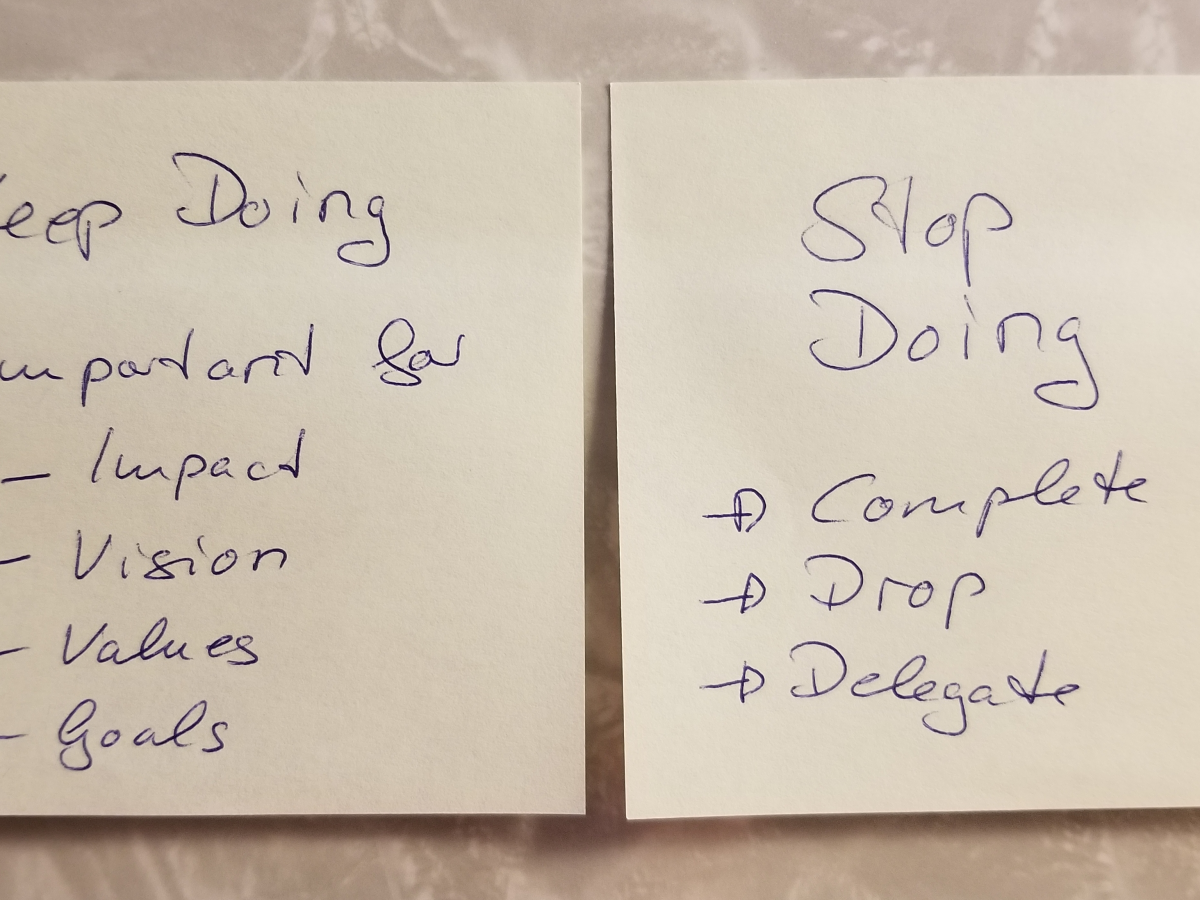This post is for you, if you find yourself in an organization that lacks a clear business strategy. Something I can relate to from many years of working with these kinds of organizations. It’s also for you if you just want to reflect and think about how to improve your current strategy with a few powerful questions.
There is one caveat: Sometimes it’s not that there is no business strategy. It might be that it’s poorly communicated (and therefore unknown), it might be that it’s misaligned between senior leadership (and therefore they each say contradictory things), it might be that it’s just bad strategy (missing a key element of an effective strategy) or that it’s intentionally kept secret (maybe because senior leaders don’t trust their own organization with their strategic insights).
Whatever the root cause of your experience of “no clear Business strategy” is, the conversations you will have will look slightly different. The good news is: Either way you have agency and options, and the ability to shape that strategy with the insights you gain from working directly with customers every day. Embrace it, it’s actually a great way to gain visibility and strategic positioning with your senior leadership team.
So how might this look in practice? We’ll first take a look at what good strategy looks like (so we can find great questions to ask). Then we’ll take a look at how to approach a dialogue about this with your business leaders so you can share and co-create product strategy with your team. Finally we’ll get to how you can turn this into an ongoing strategy dialogue with your leadership team, so that you will get to build the products people love while also contributing to your organization’s overall business’s strategy.
What are elements of a good strategy?

A good strategy consists of all five of the following elements:
1) A coherent strategy exists: This may sound funny, but simply having a coherent strategy is the first thing to look for and a source of power in itself.
At a most basic level, strategy applies strength against weaknesses or strength to the most promising opportunity. Strategy also provides clarity on direction for your team without being prescriptive on a detail level (It answers the question what problem or outcome is important to work on, and also what we will not do at the moment)
=> This creates focus and aligns people to work in the same direction.
The second part to this is the word “coherent“. In too many places there are too many competing elements in their strategy. This creates issues for product teams with contentious priority discussions and conflict around focus and product decisions.
2) There is a clear understanding of a source of power or strategic advantage. Something that sets you apart from the competition that you want to leverage to create success with your strategic goals.
3) There is a clear diagnosis of a relevant problem space. This diagnosis names or classifies your context and situation. It’s linking proven insights about patterns in customer behaviors and your market (coming e.g. from your discovery insights) with your choice on a strategic bet to pay more attention to some issues and less to others.
4) It describes concrete and coherent guiding policies. These guiding policies outline an overall approach for overcoming the obstacles highlighted by the diagnosis. A good guiding policy tackles the problems identified in the diagnosis by creating or drawing upon sources of advantage. It may specify certain market segments, ideal customer profiles and how to be of service with their jobs to be done in a way that you can do uniquely well.
5) It describes a coherent action plan (for how to apply the guiding policies in a way that uses a strategic advantage) This could be in the form of coherent outcomes you want to see. Outcomes that give a clear idea of what kind of action is wanted and should get prioritized. The important piece here is that these outcomes should not cannibalize or contradict each other, but ideally re-enforce each other by focusing energy and resources on what promise the largest progress on our desired impact (what’s phrased in our vision).
Signs of bad strategy are e.g.: there is none, it only expresses fluff without going into feasible actionable outcomes, there is no analysis of the problem space, there is an unwillingness or inability to choose a strategic bet (outcome to focus on), it’s phrased as goal setting (statements of desire, rather than plans for overcoming obstacles), it’s not clear where resources, energy and attention should get focused in a practical way that addresses the problem space.
Now, if I hold that standard against the business strategy documents I have seen in the organizations I worked at, they rarely had that clarity. And often they were shifting fragments sitting in the heads of senior leadership without clear expression towards the team. Often times because senior leaders themselves struggled to come up with a coherent strategy. It’s not an easy thing to do (else we would not see so many organizations lack a clear strategy, or missing key elements of it). So what can you do then? How do you gain the necessary clarity on business direction for your team?
How can you clarify business strategy?
You will want to talk to as senior of a leader you can have access to about their take on your business’s strategy. And ideally you want to talk to more than one of them to understand if they are on the same page with what they say. (Often they are not! Probably the best thing you can suggest to them then, is to get help discussing and aligning amongst themselves. You can summarize what you heard and ask for clarity which direction they want to follow).
If you’re in a scaleup, try to speak with your C-level leaders directly. If you’re in an enterprise, try to approach business unit leaders or other senior leaders a few levels up from where you currently contribute. And if you’re in a startup, definitely clarify your open questions with the founders and potentially their investors (if you have access).
Look first if you can find any kind of written down resource of an expression of the current strategy (maybe there was a presentation given, maybe there is an internal confluence page about it, maybe there is a dashboard they use to track progress against their strategic goals).
If you can’t find this, ask your manager if they can point you to it. If there still is nothing, then take your discovery insights with you and seek an informal conversation with the people your leadership team team. You want to approach this conversation from the mindset of “I’d like to learn as much about our strategy as I possibly can from you. And I know I can bring important insights to shape your thinking about our strategy”.
Remember: a core piece of strategy is an honest look at diagnosing the problem space in which you operate. When your team takes discovery serious and is capable to bring something like an opportunity solution tree, or an impact map filled with true customer insights into a dialogue with senior leaders, you bring a crucially important aspect of understanding the problem space to their attention. In this way you can co-shape and inform business strategy bottom-up.
Combine this with being clear on what great strategy looks like, as well as the hallmarks of bad strategy, you’ll be in a good place to phrase strategic questions that you can bring into a dialogue with your senior leadership team. By inquiring about these things with curiosity and an open mind, you’ll ask “great questions” that will clarify business strategy for you (and them!). Regardless of how imperfectly it might have been communicated (or even though of) so far.
A practical starting point for questions to bring into those conversations could be:
- What do you see as the most important customer problem we solve? What evidence do we have, that this is still their most important challenge to overcome?
=> Bring your discovery insights into that conversation!
Then ask them what else they can see from their context that you might be missing. - What do you perceive to be our biggest source of power? What do you see as our strategic advantage in our context? How did you choose this one? What experiments could help us understand fast if these assumptions are true? What can you see that would help us expand our strategic advantage?
- What is the most important strategic outcome for our organization this year? How did we choose this one? What were other things that we are choosing not to do and why?
- If there is a strategy document: Can you clarify [XYZ] for me? I’m sure when you read their strategy document, you will have questions. Showing an interest in the underlying thinking allows the person you talk to share their why for making certain strategic bets. Often you’ll surface something important this way that was not explicitly stated in the original strategy document.
A number of the concepts of good strategy I named above are rooted in Richard Rumelt’s classic book on “Good Strategy / Bad Strategy”. I highly recommend his book and also the podcast he did with Lenny Rachitsky if you’d rather listen to something: (https://www.lennyspodcast.com/good-strategy-bad-strategy-richard-rumelt/).
Another way to enter into a conversation with your senior leaders on strategy could be to say, that you listened to that podcast, and you have clarifying questions on how this applies to your business strategy. This might open their eyes to missing pieces in your business strategy that you can then potentially co-create together.
The nice side effect of seeking a dialogue about strategy with your senior leaders is, that you will be seen by them as somebody who cares about strategy, who can and wants to think strategic and who will have something relevant to say and share about their strategic priorities for the year. That visibility alone (even if you disagree on aspects of strategy) might lead to them having you in mind for a future leadership role.
Through this dialogue you’ll gain more clarity on what matters from a strategy perspective. That means you will be much better placed to contribute to your organization’s overall goals. Delivering the right outcomes will get you seen as the person who “gets important things done”. Getting important outcomes delivered is one of the key elements senior product leaders name as a contributing factor to their subsequent promotion into a senior product role.
How do you bring this back to the team?
Luckily there are a number of really great tools that help you clarify and visualize strategy for your team. The most important thing here is to create some sort of written (and ideally visualized) artefact that can be shared across your team and with your leadership. The principles of good strategy apply here as well of course:

In strong product teams, we are always creating and constantly updating a good understanding of the problem space we operate in with the discovery work we do.
Tools that help with this are e.g.: Discovery interviews, Client visits, Opportunity Solution Trees, Impact Mapping, Business Model Canvases, First half of a Design Sprint Double Diamond, Jobs to be Done definitions, etc…
What we sometimes forget to do is focus on where our strategic strength or advantage might lie. This in combination with selecting the right opportunity to focus on forms the foundation of that great product strategy.
When it comes to our guiding policies and coherent action plans, we can work with Outcome Based Roadmaps, OKRs, The Second half of a Design Sprint Double Diamond for ideation and rapid prototyping of solution ideas, Ideal Customer Profile descriptions, etc…
Based on those artefacts (and applying your understanding of business strategy as guardrails) your team and you will be able to:
– continuously improving the quality of your understanding of your problem space
– as well as the ideation around how to solve the right problems in a feasible and viable way.
Create an ongoing strategy loop with your senior leadership’s business strategy process
Start by seeking a clarifying dialogue. But don’t stop there.
My tip is to frequently share any new insight you gain in discovery, any new learning you have from shipping something, and any kind of contradictory evidence to current strategy that you find along the way with both your team and your leadership team.
This will continuously let everyone feel informed and ensure that you keep working on the right outcomes and solve the right kind of problems in a feasible and viable way. Sharing these insights continuously also gives your leadership team crucial information needed to adapt their business strategy if necessary.
Then ask, if you can participate in their strategy process. Hopefully by now they have seen you demonstrate that you have relevant input for them and that you ask the right kind of strategic questions. This alone might be enough for them to want to invite you into creating strategy with them.
It’s really helpful to discuss these findings with the aid of visualizations. That could be an opportunity solution tree, a Business Model Canvas, a Jobs to be Done Canvas, or your Outcome Based roadmap that shows a discovery and a delivery track together with the most important metrics you’re tracking to judge your progress against your goals.
Visual artefacts help you to communicate findings in a neutral way. You want your senior leaders as well as your team in dialogue with you and have them feel like you’re collaborating on getting clarity on changes in context or user insights in a useful way.
Remember: There is never only one possible strategic bet you can take. And each strategic bet chosen by product leadership or your senior leadership team is exactly that: a bet. It is crucial to find out fast whether focusing your resources on this particular bet is delivering the expected outcomes, or not. Your teams likely have (or can create) the data to judge that.
With that you can be incredibly helpful to the business leadership in your organization and provide enough clarity on direction for your team to prioritize initiatives delivering the most important outcomes.
In summary:
- Learn the characteristics of good and bad strategy (to know how to fill the gaps if needed)
- Engage in an exploratory and curious dialogue with your senior leaders on business strategy (and bring relevant insights with you!). Use good strategic questions to get clarity from them (or get them to start thinking about how to get to that clarity with you).
- Make your team your ally by sharing transparently what your organization’s goals are, and how your work relates to them (e.g. with your findings on Business Strategy, The Vision Statement, your Product Strategy, Your OKRs, Your Outcome Based Roadmap)
- Create a loop between the findings of your team and your senior leadership’s business strategy process. They inform each other and can’t function as a coherent set of guiding principles if they are not aligned.
If you’d like help on how to navigate this with your team, reach out anytime with your questions. Or let’s work on your strategy process together!
___________________________
If you would like to explore this more: reach out for a free coaching session with me.
I coach, speak, do workshops and blog about #leadership, #product leadership, #AIEthics #innovation, the #importance of creating a culture of belonging and how to succeed with your #hybrid or #remote teams.
Get my latest blog posts delivered directly to your inbox.
Your email address will only be used for receiving emails with my latest blog posts in them. You can unsubscribe at any point in time.
If you enjoyed reading this post, you may enjoy the following posts as well:
Mastering Focus: Strategies for busy Product Leaders
Do you know that feeling of dissatisfaction with your day because you feel like you made no meaningful progress? That too many distractions got in the way of you focusing on deep work today. You may also know this vague feeling of failing because direction, strategy and what to prioritize are not crystal clear for…
Evolving as a Product Leader: Skills and Strategies
We would all love it, if we could simply be great at product, or at leadership, or at public speaking, or an expert on AI, or great at discovering and phrasing vision and strategy or super focused or finally find a healthy work-life balance. We admire those people who have mastered a skill we’d like…
The Power of Completion
We each have only a few hours of time to be productive with work each day. Managing our time wisely, being intentional about what we give priority (and what we decide not to do) is a key skill in product work and in life. When I was working in product roles, it always felt like…
Why inclusivity matters
Looking at the world today one thing is clear to me: violence does not nurture peace. And the only way to come together as a human family is to patiently do the work of building inclusive spaces. Spaces that allow all of us to exist, that come with fair access to opportunities, that make us…
The art of persuasion
Persuasion is about influence. It is a super useful skill to invite your team to co-create with you. So often in product roles, this is exactly what we could use more of. Persuasion skills could help you to be able to agree on a strategy, or to get to alignment on our OKRs or the…
Vulnerability – a key skill for product leaders
It takes a healthy dose of courage and self-awareness to be ok with vulnerability. To become aware of how it affects your relationships and to start consciously using it to improve your working relationships. It took me quite a few loops to become aware, start experimenting with it and start learning how vulnerability turns into…






